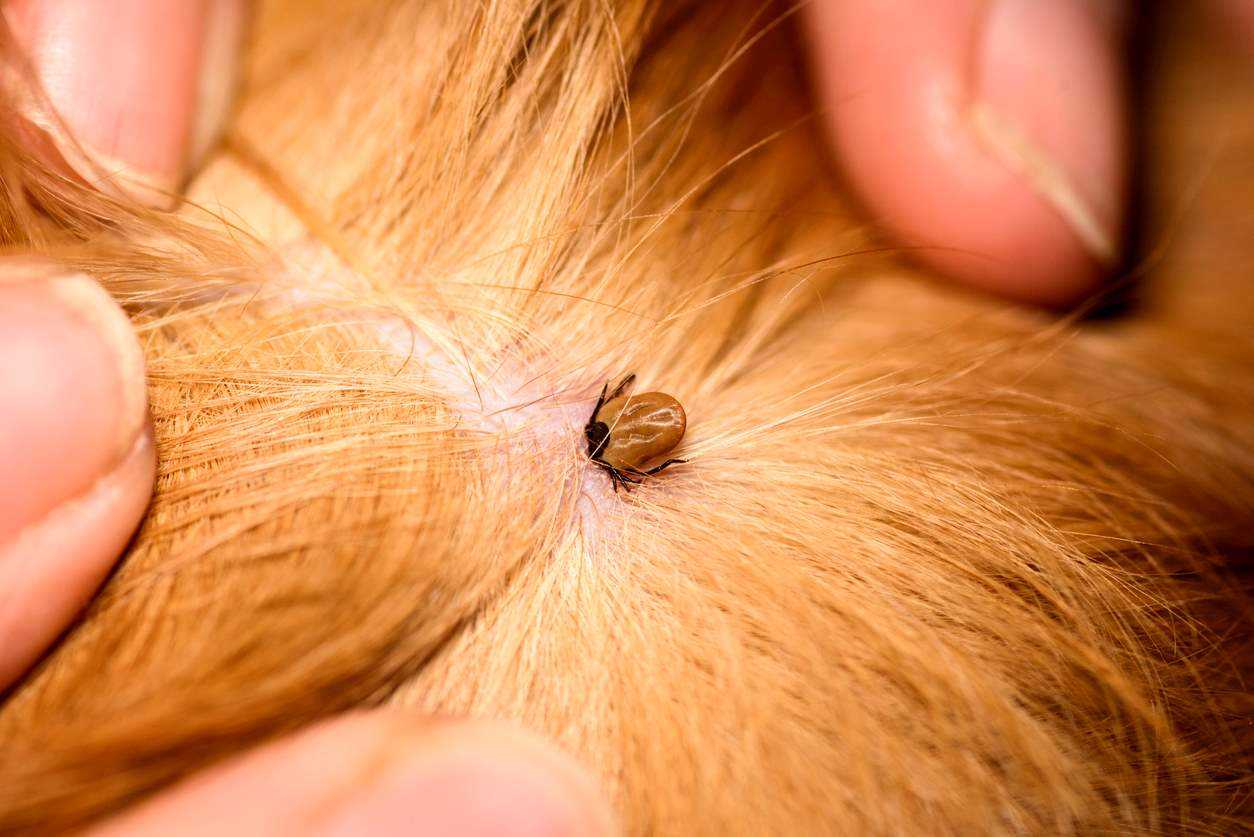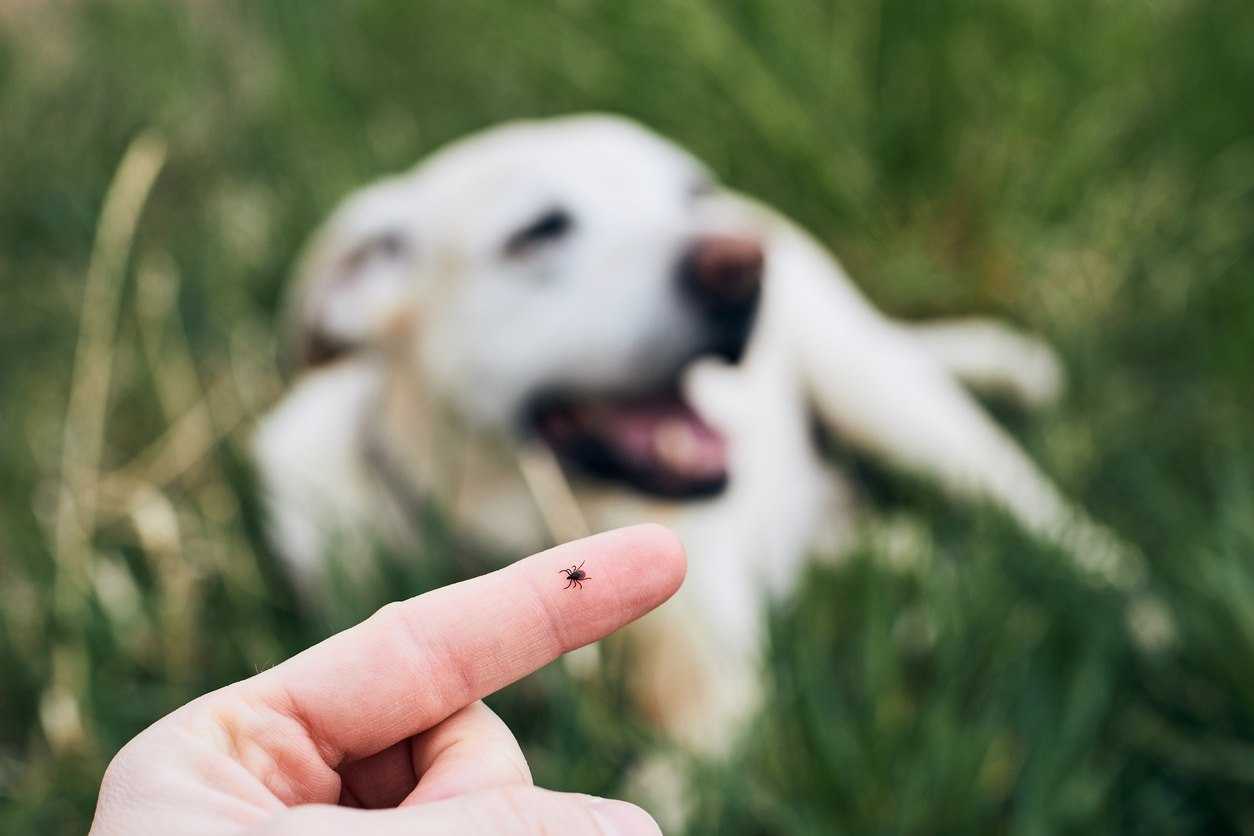If you live around the woods, tall grasses, or swaths of brush, you’ve likely had a couple (or more) run-ins with ticks—one of nature’s most notorious bloodsuckers. Ticks, on top of their generally unsettling nature and appearance, can pose troublesome as carriers of various diseases, most notably Lyme disease, Rocky Mountain spotted fever, and ehrlichiosis.
Finding a tick on yourself is unpleasant, but it’s even worse when we find them on our favorite furry friends, since dogs and cats often either don’t notice the bugs riding them around, don’t understand their danger, and don’t have a safe way to remove them.
In this article, PURCOR Pest Solutions wants to leverage our years of experience in the field of pest extermination to lift the veil on any uncertainties you may have surrounding ticks, and how to keep your pets safe when you identify a tick making a meal out of them. We’ll show you how to remove a tick on a dog, what kills ticks on cats instantly, and how to identify this notorious pest for quick disposal.
You want to keep your pets safe, and we believe that should be as easy and intuitive as possible. The peace of mind and confidence you’ll find at the end of this read will be worth it.
What Does a Tick Look Like on a Dog?

Ticks, like many creatures, come in many different varieties and colors, however we think there’s a quick and easy way to identify most of them. What does a tick on a dog look like? You’ll find most ticks are reddish-brown, have eight legs, and are a flat oval shape that inflates when fully engorged on the blood of their prey. Most full-sized ticks will be 1 centimeter in length, though they do come in smaller and larger sizes depending on the exact species of tick.
Because they need skin-to-skin contact to feed, you may need to rifle through your pet’s fur in order to locate them, unless they’re on more exposed locations, like the belly or legs. Because your pet likely has a pink, fleshy color for skin, this means ticks, especially ones that have already drained some blood, will stand out.
However, we want to draw your attention to some of the less obvious spots where a tick may latch onto your dog. If you suspect a tick may be upsetting your pet (they may be scratching at themselves, or trying to pick away at the tick with their teeth, or have a loss of appetite), then check the following locations:
- Under the front legs
- Behind the back legs
- Around the tail
- Around the eyelids
- Surrounding or inside ears
- Beneath the collar
- Tucked between toes
The reason these spots are more likely than others, is because anywhere else, your dog may be capable of biting or scratching the tick off on their own. These are less vulnerable locations, and safer for ticks to stake their claim. If you’re looking for a tick on your dog, start here.
How to Remove a Tick on a Dog

If you locate a tick on your dog, PURCOR Pest Solutions recommends following the measures of removal put forth by the Centers for Disease Control, but will provide for you a summary.
- While you may use any number of purchasable devices or instruments when deciding how to remove a tick on a dog, we recommend using a basic pair of clean, fine-tipped tweezers to pull off the tick. Do this as close to the skin’s surface as you are able.
- Pull the tick directly upwards and don’t yank. Steadily apply more pressure until it unlatches.
- Rinse the bite area with rubbing alcohol or soap and water. Take care to also clean and sanitize your hands.
- Place the tick in alcohol, a sealed bag/container, or flush it down the toilet for adequate disposal.
In case any medical developments occur following the tick’s removal, we suggest taking a picture of the tick and the bite mark for professional evaluation later. Check the space of the bite regularly to monitor for ongoing irritation or other blemishes that should disappear after a couple weeks. If they do not, or your dog develops unusual behavior, consult your local veterinarian.
What Kills Ticks on Cats Instantly?
The approach we take to caring for our feline companions is mostly the same as our approach to dogs, but there are some additional methods we want to address (which may be interchangeable with your approach to removing ticks on dogs—consult your local vet for guidance).
If you’re looking for an immediate solution, the closest we can advise is implementing the use of veterinary-approved tick prevention products, such as topical spot-on treatments, oral medications, or tick collars that are specifically designed for cats. However, in terms of timelines, these products are formulated to safely and effectively eradicate ticks over a period of time, rather than providing an instant result. For instant tick relief, your best bet is the same approach we suggested above, courtesy of Centers for Disease Control.
We hope you have a good pair of tweezers!
But if you don’t have tweezers, or you’d rather utilize some home remedies, we have a few tips for that, too.
- Cedar oil spray. A fantastic non-toxic option, cedar oil greatly deters ticks and other insects, acting as a natural repellent that is also capable of killing the.
- Apple cider vinegar. Not just a great healthy drink for you, but a potent tool in shooing away pesky ticks, apple cider vinegar can do wonders if mixed with water and neem oil. Apply the solution to your cat, its bed, and other areas around your home.
- Aromatherapy essential oils. If you’re not keen on applying something directly to your pet, try influencing the air itself. Like many other pests, ticks tend to avoid cinnamon, lavender, peppermint, and other high concentrations of powerful odors. Just make sure it doesn’t bother your cat, too!
If you’re asking what a tick looks like on a cat, the answer is the same as with dogs: reddish brown, eight legs, and inflated red sacks if they’ve recently fed. If you find ticks keep making their way onto your cat, do what you can to monitor their activity, especially if they trek outside, and try to locate where the problem may be coming from. Do routine checks behind their legs, around their hind quarters, and other areas where your cat may have a hard time reaching.
Take A Tactical Approach to Healthier Pets
Some tick species are expanding their ranges and encroaching on new territories, something easy for them to achieve since they literally hitch a ride with their hosts (for this reason, if you take your pet on a trip, make sure to check for ticks before bringing them back home). They are also frustratingly resistant to seasonal changes, so no matter what time of year it is, you can find them.
Ticks are not something any of us should take lightly. When we underestimate the damage they can cause, we create an opportunity to invite disease into the lives of our pets. Luckily, professional pest control is a great option for keeping ticks away from your pets, so you never have to perform another emergency tick removal.
Contact PURCOR Today for Tick Control Solutions
Unfortunately, your lawn or yard can be a natural playground for all manner of insects. That’s why our trained pest technicians know how to employ integrated pest management solutions to help keep your yard free of ticks, fleas, mosquitoes, and other unwanted pests. If you find yourself dealing with ticks this summer, don’t try to deal with the problem yourself–call PURCOR immediately for expert pest control services.
If you have any questions about our practices, approach, or pricing, don’t hesitate to contact us online or give us a call.
"*" indicates required fields
"*" indicates required fields




